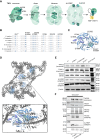TREX tetramer disruption alters RNA processing necessary for corticogenesis in THOC6 Intellectual Disability Syndrome
- PMID: 38388531
- PMCID: PMC10884030
- DOI: 10.1038/s41467-024-45948-y
TREX tetramer disruption alters RNA processing necessary for corticogenesis in THOC6 Intellectual Disability Syndrome
Abstract
THOC6 variants are the genetic basis of autosomal recessive THOC6 Intellectual Disability Syndrome (TIDS). THOC6 is critical for mammalian Transcription Export complex (TREX) tetramer formation, which is composed of four six-subunit THO monomers. The TREX tetramer facilitates mammalian RNA processing, in addition to the nuclear mRNA export functions of the TREX dimer conserved through yeast. Human and mouse TIDS model systems revealed novel THOC6-dependent, species-specific TREX tetramer functions. Germline biallelic Thoc6 loss-of-function (LOF) variants result in mouse embryonic lethality. Biallelic THOC6 LOF variants reduce the binding affinity of ALYREF to THOC5 without affecting the protein expression of TREX members, implicating impaired TREX tetramer formation. Defects in RNA nuclear export functions were not detected in biallelic THOC6 LOF human neural cells. Instead, mis-splicing was detected in human and mouse neural tissue, revealing novel THOC6-mediated TREX coordination of mRNA processing. We demonstrate that THOC6 is required for key signaling pathways known to regulate the transition from proliferative to neurogenic divisions during human corticogenesis. Together, these findings implicate altered RNA processing in the developmental biology of TIDS neuropathology.
© 2024. The Author(s).
Conflict of interest statement
The authors declare no competing interests.
Figures







Update of
-
Mechanisms of mRNA processing defects in inherited THOC6 intellectual disability syndrome.Res Sq [Preprint]. 2023 Sep 6:rs.3.rs-2126145. doi: 10.21203/rs.3.rs-2126145/v1. Res Sq. 2023. Update in: Nat Commun. 2024 Feb 22;15(1):1640. doi: 10.1038/s41467-024-45948-y. PMID: 37720017 Free PMC article. Updated. Preprint.
Similar articles
-
Mechanisms of mRNA processing defects in inherited THOC6 intellectual disability syndrome.Res Sq [Preprint]. 2023 Sep 6:rs.3.rs-2126145. doi: 10.21203/rs.3.rs-2126145/v1. Res Sq. 2023. Update in: Nat Commun. 2024 Feb 22;15(1):1640. doi: 10.1038/s41467-024-45948-y. PMID: 37720017 Free PMC article. Updated. Preprint.
-
Transcription-Export complex in neurodevelopmental disorders.Curr Opin Genet Dev. 2025 Oct;94:102380. doi: 10.1016/j.gde.2025.102380. Epub 2025 Jul 11. Curr Opin Genet Dev. 2025. PMID: 40651286 Review.
-
Autosomal recessive mutations in THOC6 cause intellectual disability: syndrome delineation requiring forward and reverse phenotyping.Clin Genet. 2017 Jan;91(1):92-99. doi: 10.1111/cge.12793. Epub 2016 May 24. Clin Genet. 2017. PMID: 27102954
-
Structural mechanism of DDX39B regulation by human TREX-2 and a related complex in mRNP remodeling.Nat Commun. 2025 Jul 1;16(1):5471. doi: 10.1038/s41467-025-60547-1. Nat Commun. 2025. PMID: 40595470 Free PMC article.
-
The Lived Experience of Autistic Adults in Employment: A Systematic Search and Synthesis.Autism Adulthood. 2024 Dec 2;6(4):495-509. doi: 10.1089/aut.2022.0114. eCollection 2024 Dec. Autism Adulthood. 2024. PMID: 40018061 Review.
Cited by
-
Expanding the phenotypic spectrum of Beaulieu-Boycott-Innes syndrome: A case report of a novel THOC6 gene mutation associated with ambiguous genitalia and disorders of sexual development.Medicine (Baltimore). 2025 Aug 1;104(31):e43621. doi: 10.1097/MD.0000000000043621. Medicine (Baltimore). 2025. PMID: 40760536 Free PMC article.
References
-
- Schalock RL, Luckasson R, Tassé MJ. An overview of intellectual disability: definition, diagnosis, classification, and systems of supports (12th ed.) Am. J. Intellect. Dev. Disabil. 2021;126:439–442. - PubMed
-
- Retterer K, et al. Clinical application of whole-exome sequencing across clinical indications. Genet. Med. 2016;18:696–704. - PubMed
MeSH terms
Substances
Grants and funding
LinkOut - more resources
Full Text Sources
Molecular Biology Databases

